Small overlap front: driver-side
Rating applies to 2013-19 models
Tested vehicle: 2014 Ford Explorer XLT 4-door 4wd
The Ford Explorer was redesigned for the 2011 model year. Beginning with 2013 models, the seat belts and airbags were modified.
| Evaluation criteria | Rating |
|---|---|
| Structure and safety cage | |
| Driver injury measures | |
| Head/neck | |
| Chest | |
| Hip/thigh | |
| Lower leg/foot | |
|
Driver restraints and dummy kinematics
The dummy’s head barely contacted the frontal airbag before sliding off the left side as the steering column moved 17 cm to the right, leaving the head vulnerable to contact with forward structure and allowing little airbag cushioning for the chest. The side curtain airbag deployed and has sufficient forward coverage to protect the head from contact with side structure and outside objects. The side torso airbag also deployed. | |
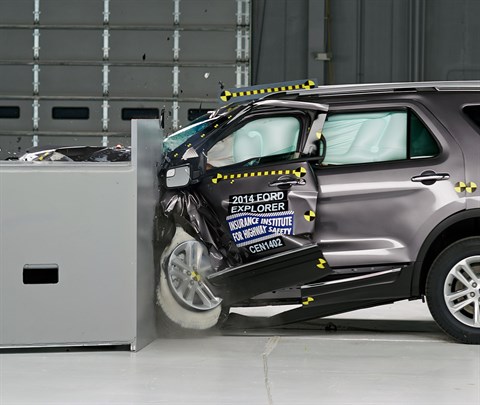
Action shot taken during the driver-side small overlap frontal crash test.
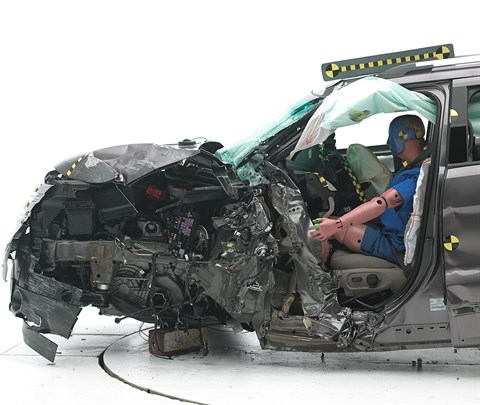
The dummy's position in relation to the door frame, steering wheel, and instrument panel after the crash test indicates that the driver's survival space was not maintained well.
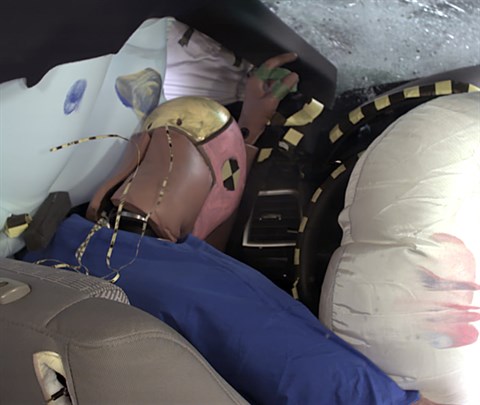
During the crash, the dummy's head and torso barely contacted the airbag before sliding off to the left as the steering column moved to the right.
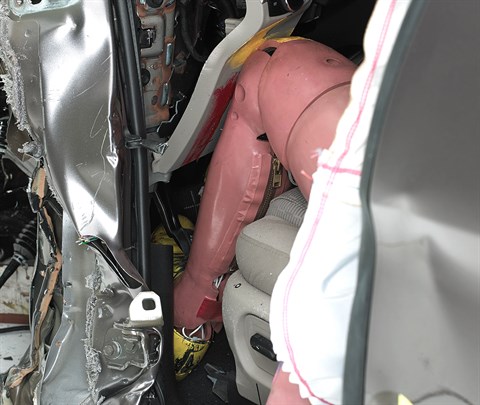
Door hinge pillar and instrument panel intrusion was extensive and contributed to a moderate risk of injuries to the left knee and lower leg.
Measures of occupant compartment intrusion on driver side
| Evaluation criteria | Measurement |
|---|---|
| Test ID | CEN1402 |
| Lower occupant compartment | |
| Lower hinge pillar max (cm) | 34 |
| Footrest (cm) | 11 |
| Left toepan (cm) | 9 |
| Brake pedal (cm) | 8 |
| Parking brake (cm) | 18 |
| Rocker panel lateral average (cm) | 4 |
| Upper occupant compartment | |
| Steering column | 13 |
| Upper hinge pillar max (cm) | 26 |
| Upper dash (cm) | 23 |
| Lower instrument panel (cm) | 20 |
Driver injury measures
| Evaluation criteria | Measurement |
|---|---|
| Test ID | CEN1402 |
| Head | |
| HIC-15 | 93 |
| Peak gs at hard contact | no contact |
| Neck | |
| Tension (kN) | 1.4 |
| Extension bending moment (Nm) | 14 |
| Maximum Nij | 0.27 |
| Chest maximum compression (mm) | 23 |
| Femur (kN) | |
| Left | 3.7 |
| Right | 2.2 |
| Knee displacement (mm) | |
| Left | 14 |
| Right | 3 |
| Knee-thigh-hip injury risk (%) | |
| Left | 1 |
| Right | 0 |
| Maximum tibia index | |
| Left | 0.87 |
| Right | 0.61 |
| Tibia axial force (kN) | |
| Left | 2.2 |
| Right | 0.6 |
| Foot acceleration (g) | |
| Left | 63 |
| Right | 93 |
Small overlap front: passenger-side
Rating applies to 2013-19 models
Tested vehicle: 2018 Ford Explorer XLT 4-door 4wd
The Ford Explorer was redesigned for the 2011 model year. Beginning with 2013 models, the seat belts and frontal airbags were modified, and a knee airbag for the front passenger was added.
| Evaluation criteria | Rating |
|---|---|
| Overall evaluation | |
| Structure and safety cage | |
| Passenger injury measures | |
| Head/neck | |
| Chest | |
| Hip/thigh | |
| Lower leg/foot | |
|
Passenger restraints and dummy kinematics
The dummy’s head contacted the frontal airbag but began to roll toward the right side, leaving the head vulnerable to contact with forward structure. The side curtain airbag deployed and has sufficient forward coverage to protect the head from contact with side structure and outside objects. The side torso airbag also deployed. | |
| Driver injury measures | |
| Head/neck | |
| Chest | |
| Hip/thigh | |
| Lower leg/foot | |
| Driver restraints and dummy kinematics | |
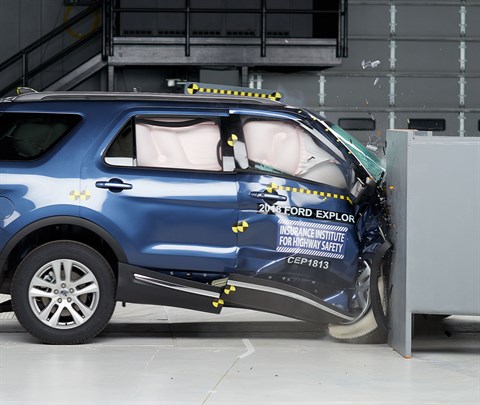
Action shot taken during the passenger-side small overlap frontal crash test.
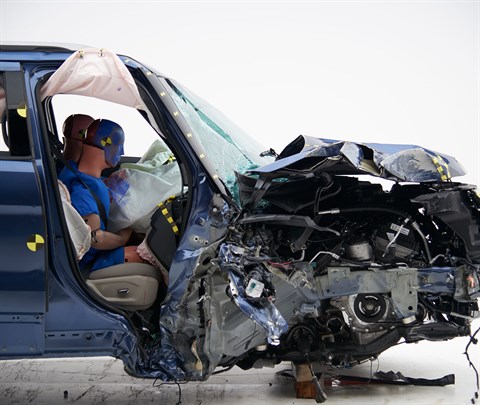
The dummy's position in relation to the door frame and dashboard after the crash test indicates that the passenger's survival space was not maintained well.
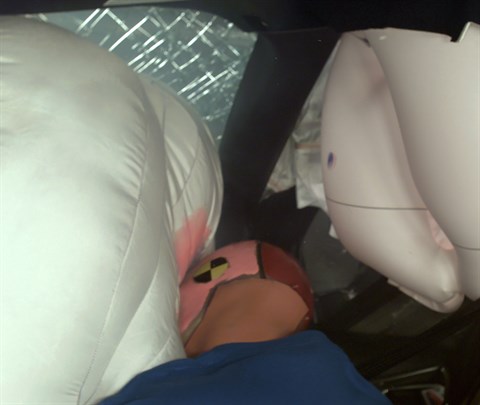
The dummy's head contacted the frontal airbag but then rolled around to the right.

Extensive intrusion of the dashboard and door hinge pillar contributed to a likely risk of injury to the right hip and a possible risk to the left lower leg.
Measures of occupant compartment intrusion on passenger side
| Evaluation criteria | Measurement |
|---|---|
| Test ID | CEP1813 |
| Lower occupant compartment | |
| Lower hinge pillar max (cm) | 38 |
| Footrest (cm) | 25 |
| Right toepan (cm) | 22 |
| Center toepan (cm) | 17 |
| Rocker panel lateral average (cm) | 15 |
| Upper occupant compartment | |
| Center dash (cm) | 25 |
| Upper hinge pillar max (cm) | 33 |
| Upper dash (cm) | 32 |
| Right lower dash (cm) | 28 |
Passenger injury measures
| Evaluation criteria | Measurement |
|---|---|
| Test ID | CEP1813 |
| Head | |
| HIC-15 | 72 |
| Peak gs at hard contact | no contact |
| Neck | |
| Tension (kN) | 1.1 |
| Extension bending moment (Nm) | 15 |
| Maximum Nij | 0.25 |
| Chest maximum compression (mm) | 21 |
| Femur (kN) | |
| Left | 1.8 |
| Right | 6.7 |
| Knee displacement (mm) | |
| Left | 5 |
| Right | 8 |
| Knee-thigh-hip injury risk (%) | |
| Left | 0 |
| Right | 32 |
| Maximum tibia index | |
| Left | 0.96 |
| Right | 0.77 |
| Tibia axial force (kN) | |
| Left | 0.5 |
| Right | 2.7 |
| Foot acceleration (g) | |
| Left | 53 |
| Right | 57 |
Driver injury measures
| Evaluation criteria | Measurement |
|---|---|
| Test ID | CEP1813 |
| Head | |
| HIC-15 | 13 |
| Peak gs at hard contact | no contact |
| Neck | |
| Tension (kN) | 0.5 |
| Extension bending moment (Nm) | 10 |
| Maximum Nij | 0.13 |
| Chest maximum compression (mm) | 19 |
| Femur (kN) | |
| Left | 0.0 |
| Right | 0.3 |
| Knee displacement (mm) | |
| Left | 1 |
| Right | 2 |
| Knee-thigh-hip injury risk (%) | |
| Left | 0 |
| Right | 0 |
| Maximum tibia index | |
| Left | 0.31 |
| Right | 0.26 |
| Tibia axial force (kN) | |
| Left | 0.1 |
| Right | 0.6 |
| Foot acceleration (g) | |
| Left | 29 |
| Right | 20 |
Moderate overlap front: original test
Rating applies to 2011-19 models
Tested vehicle: 2011 Ford Explorer XLT 4-door 4wd
The Ford Explorer was redesigned for the 2011 model year and now shares the same basic design as the Ford Flex. Frontal ratings are assigned by the Institute based on a test conducted by Ford.
| Evaluation criteria | Rating |
|---|---|
| Overall evaluation | |
| Structure and safety cage | |
| Driver injury measures | |
| Head/neck | |
| Chest | |
| Leg/foot, left | |
| Leg/foot, right | |
| Driver restraints and dummy kinematics | |
Measures of occupant compartment intrusion on driver side
| Evaluation criteria | Measurement |
|---|---|
| Test ID | VTF1014 |
| Footwell intrusion | |
| Footrest (cm) | 5 |
| Left (cm) | 8 |
| Center (cm) | 16 |
| Right (cm) | 14 |
| Brake pedal (cm) | 9 |
| Instrument panel rearward movement | |
| Left (cm) | 5 |
| Right (cm) | 5 |
| Steering column movement | |
| Upward (cm) | -1 |
| Rearward (cm) | 0 |
| A-pillar rearward movement (cm) | 0 |
Driver injury measures
| Evaluation criteria | Measurement |
|---|---|
| Test ID | VTF1014 |
| Head | |
| HIC-15 | 261 |
| Peak gs at hard contact | no contact |
| Neck | |
| Tension (kN) | 1.3 |
| Extension bending moment (Nm) | 8 |
| Maximum Nij | 0.25 |
| Chest maximum compression (mm) | 31 |
| Legs | |
| Femur force - left (kN) | 0.6 |
| Femur force - right (kN) | 3.0 |
| Knee displacement - left (mm) | 5 |
| Knee displacement - right (mm) | 2 |
| Maximum tibia index - left | 0.18 |
| Maximum tibia index - right | 0.60 |
| Tibia axial force - left (kN) | 1.0 |
| Tibia axial force - right (kN) | 1.8 |
| Foot acceleration (g) | |
| Left | 65 |
| Right | 91 |
Side: original test
Rating applies to 2016-19 models
Tested vehicle: 2016 Ford Explorer 4-door 4wd
The Ford Explorer was redesigned for the 2011 model year. Beginning with 2016 models, the front seat structure, front seat-mounted side torso airbags, and front and rear door trim were modified to improve occupant protection in side impact crashes. Side ratings are assigned by the Institute based on a test conducted by Ford.
Because there were no changes to the vehicle's body structure since 2011, the structure rating is based on both this test and an earlier test of a 2011 model Explorer conducted by Ford under the test verification procedure.
| Evaluation criteria | Rating |
|---|---|
| Overall evaluation | |
| Structure and safety cage | |
| Driver injury measures | |
| Head/neck | |
| Torso | |
| Pelvis/leg | |
| Driver head protection | |
| Rear passenger injury measures | |
| Head/neck | |
| Torso | |
| Pelvis/leg | |
| Rear passenger head protection | |
Measures of occupant compartment intrusion on driver side
| Test ID | VTS1502 | VTS1013 |
|---|---|---|
| B-pillar to longitudinal centerline of driver's seat (cm) | -20.5 | -23.5 |
| Negative numbers indicate the amount by which the crush stopped short of the seat centerline. | ||
Driver injury measures
| Evaluation criteria | Measurement |
|---|---|
| Test ID | VTS1502 |
| Head HIC-15 | 88 |
| Neck | |
| Tension (kN) | 1.0 |
| Compression (kN) | 0.2 |
| Shoulder | |
| Lateral deflection (mm) | 21 |
| Lateral force (kN) | 1.0 |
| Torso | |
| Maximum deflection (mm) | 31 |
| Average deflection (mm) | 23 |
| Maximum deflection rate (m/s) | 2.40 |
| Maximum viscous criterion (m/s) | 0.30 |
| Pelvis | |
| Iliac force (kN) | 1.6 |
| Acetabulum force (kN) | 1.5 |
| Combined force (kN) | 2.9 |
| Left femur | |
| L-M force (kN) | 0.4 |
| L-M moment (Nm) | 105 |
| A-P moment (Nm) | 17 |
Passenger injury measures
| Evaluation criteria | Measurement |
|---|---|
| Test ID | VTS1502 |
| Head HIC-15 | 63 |
| Neck | |
| Tension (kN) | 0.1 |
| Compression (kN) | 0.2 |
| Shoulder | |
| Lateral deflection (mm) | 22 |
| Lateral force (kN) | 1.4 |
| Torso | |
| Maximum deflection (mm) | 23 |
| Average deflection (mm) | 19 |
| Maximum deflection rate (m/s) | 3.20 |
| Maximum viscous criterion (m/s) | 0.30 |
| Pelvis | |
| Iliac force (kN) | 0.3 |
| Acetabulum force (kN) | 1.6 |
| Combined force (kN) | 1.8 |
| Left femur | |
| L-M force (kN) | 0.2 |
| L-M moment (Nm) | 38 |
| A-P moment (Nm) | 22 |
Roof strength
Rating applies to 2011-19 models
Tested vehicle: 2011 Ford Explorer XLT 4-door 4wd
| Overall evaluation | |
|---|---|
| Curb weight | 4,661 lbs |
| Peak force | 21,347 lbs |
| Strength-to-weight ratio | 4.58 |
Headlights
Ratings are given for 2 different headlight variations available on this vehicle.
Trim level(s)
- Platinum trim
- Limited trim equipped with Equipment Group 301a package
| Evaluation criteria | Rating |
|---|---|
| Low-beam headlight type | LED reflector |
| High-beam headlight type | Halogen reflector |
| Curve-adaptive? | No |
| High-beam assist? | Yes |
|
Overall rating | |
| Distance at which headlights provide at least 5 lux illumination: | |
Low beams
On the straightaway, visibility was good on both sides of the road. On curves, visibility was fair on the sharp left and both right curves and inadequate on the gradual left curve.
The low beams created excessive glare.
High beams
On the straightaway, visibility was good on the right side of the road and inadequate on the left side. On curves, visibility was fair on both right curves and inadequate on both left curves.
High-beam assist compensates for some limitations of this vehicle's low beams on both left curves and on both right curves.
| Evaluation criteria | Measurement |
|---|---|
| Trim level(s) |
|
| Low-beam headlight type | LED reflector |
| High-beam headlight type | Halogen reflector |
| Curve-adaptive? | No |
| High-beam assist? | Yes |
|
Overall rating Applies to 2017 models |
| LOW BEAMS | Average minimum useful illumination distance (5 lux) |
Amount glare exceeded threshold |
|---|---|---|
| Straightaway right edge | 106.2 m | 91.2% |
| Straightaway left edge | 61.7 m | 91.2% |
| 250m radius right curve, right edge | 59.7 m | 32.7% |
| 250m radius left curve, left edge | 52.2 m | 99.6% |
| 150m radius right curve, right edge | 51.2 m | 15.0% |
| 150m radius left curve, left edge | 47.7 m | 94.3% |
| HIGH BEAMS | Average minimum useful illumination distance (5 lux) |
|---|---|
| Straightaway right edge | 161.4 m |
| Straightaway left edge | 121.5 m |
| 250m radius right curve, right edge | 69.7 m |
| 250m radius left curve, left edge | 64.0 m |
| 150m radius right curve, right edge | 55.2 m |
| 150m radius left curve, left edge | 52.8 m |
Trim level(s)
- Explorer trim
- XLT trim
- Limited trim
- Sport trim
| Evaluation criteria | Rating |
|---|---|
| Low-beam headlight type | LED reflector |
| High-beam headlight type | Halogen reflector |
| Curve-adaptive? | No |
| High-beam assist? | No |
|
Overall rating | |
| Distance at which headlights provide at least 5 lux illumination: | |
Low beams
On the straightaway, visibility was good on both sides of the road. On curves, visibility was fair on the sharp left and both right curves and inadequate on the gradual left curve.
The low beams created excessive glare.
High beams
On the straightaway, visibility was good on the right side of the road and inadequate on the left side. On curves, visibility was fair on both right curves and inadequate on both left curves.
| Evaluation criteria | Measurement |
|---|---|
| Trim level(s) |
|
| Low-beam headlight type | LED reflector |
| High-beam headlight type | Halogen reflector |
| Curve-adaptive? | No |
| High-beam assist? | No |
|
Overall rating Applies to 2017 models |
| LOW BEAMS | Average minimum useful illumination distance (5 lux) |
Amount glare exceeded threshold |
|---|---|---|
| Straightaway right edge | 106.2 m | 91.2% |
| Straightaway left edge | 61.7 m | 91.2% |
| 250m radius right curve, right edge | 59.7 m | 32.7% |
| 250m radius left curve, left edge | 52.2 m | 99.6% |
| 150m radius right curve, right edge | 51.2 m | 15.0% |
| 150m radius left curve, left edge | 47.7 m | 94.3% |
| HIGH BEAMS | Average minimum useful illumination distance (5 lux) |
|---|---|
| Straightaway right edge | 161.4 m |
| Straightaway left edge | 121.5 m |
| 250m radius right curve, right edge | 69.7 m |
| 250m radius left curve, left edge | 64.0 m |
| 150m radius right curve, right edge | 55.2 m |
| 150m radius left curve, left edge | 52.8 m |
Front crash prevention: vehicle-to-vehicle
Child seat anchors
Rating applies to 2015-19 models
| Evaluation criteria | Rating |
|---|---|
| Overall evaluation | |
| Vehicle trim | XLT |
| Seat type | cloth |
This vehicle has 3 rear seating positions with complete child seat attachment (LATCH) hardware.
It has 1 additional seating position with a tether anchor and the ability to borrow lower anchors from the other seating positions.
Note: When anchors are borrowed, they aren't available to use in their designated positions.
| Evaluation criteria | Rating |
|---|---|
| Overall evaluation | |
| Vehicle trim | XLT |
| Seat type | cloth |
| Rating icon | Rating |
|---|---|
| G | Good |
| A | Acceptable |
| M | Marginal |
| P | Poor |
| Seating positions that rely on borrowed lower anchors or have only a tether anchor available are not rated. | |
thether anchor symbol | Tether anchor |
lower anchor symbol | Lower anchors |
| Lower anchor(s) can be borrowed from adjacent positions(s) | |
| No hardware available |
Details by seating position
| Position | Rating |
|---|---|
| 1 | |
| Tether anchor | |
| hard-to-find location | |
| no other hardware could be confused for anchor | |
| Lower anchors | |
| too deep in seat | |
| not too much force needed to attach | |
| easy to maneuver around anchors | |
| 2 | |
| Tether anchor | |
| hard-to-find location | |
| no other hardware could be confused for anchor | |
| Lower anchors | |
| Can be borrowed from 1 and 3 | |
| 3 | |
| Tether anchor | |
| hard-to-find location | |
| no other hardware could be confused for anchor | |
| Lower anchors | |
| too deep in seat | |
| not too much force needed to attach | |
| easy to maneuver around anchors | |
| 4 | |
| Tether anchor | |
| hard-to-find location | |
| other hardware could be confused for anchor | |
| Lower anchors | |
| not too deep in seat | |
| not too much force needed to attach | |
| easy to maneuver around anchors |
Seat position 21
| Lower anchor A | |
|---|---|
| Open access rated | No |
| Depth (cm) | 2-4 |
| Force (lbs) | 14 |
| Clearance angle (degrees) | 64 |
| Lower anchor B | |
| Open access rated | No |
| Depth (cm) | 2-4 |
| Force (lbs) | 21 |
| Clearance angle (degrees) | 59 |
| Tether anchor | |
| Location | Bottom seatback |
| Confusing hardware present | No |
| Has contrasting label within 3 inches of tether anchor |
No |
| Tether anchors can be accessed while seatback is properly positioned for use of LATCH |
Not measured |
Seat position 22
| Lower anchor A | |
|---|---|
| Lower latch is shared for this seat position | |
| Lower anchor B | |
| Lower latch is shared for this seat position | |
| Tether anchor | |
| Location | Bottom seatback |
| Confusing hardware present | No |
| Has contrasting label within 3 inches of tether anchor |
No |
| Tether anchors can be accessed while seatback is properly positioned for use of LATCH |
Not measured |
Seat position 23
| Lower anchor A | |
|---|---|
| Open access rated | No |
| Depth (cm) | 2-4 |
| Force (lbs) | 19 |
| Clearance angle (degrees) | 63 |
| Lower anchor B | |
| Open access rated | No |
| Depth (cm) | 2-4 |
| Force (lbs) | 31 |
| Clearance angle (degrees) | 63 |
| Tether anchor | |
| Location | Bottom seatback |
| Confusing hardware present | No |
| Has contrasting label within 3 inches of tether anchor |
No |
| Tether anchors can be accessed while seatback is properly positioned for use of LATCH |
Not measured |
Seat position 33
| Lower anchor A | |
|---|---|
| Open access rated | No |
| Depth (cm) | -2-0 |
| Force (lbs) | 0 |
| Clearance angle (degrees) | 80 |
| Lower anchor B | |
| Open access rated | No |
| Depth (cm) | -2-0 |
| Force (lbs) | 0 |
| Clearance angle (degrees) | 80 |
| Tether anchor | |
| Location | Bottom seatback |
| Confusing hardware present | Yes |
| Has contrasting label within 3 inches of tether anchor |
No |
| Tether anchors can be accessed while seatback is properly positioned for use of LATCH |
Not measured |
